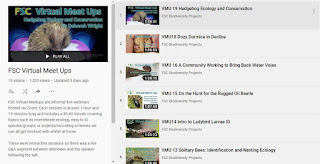If waking up some mornings with the lockdown blues, here are some alternative on-line wildlife events, some local, some not so local ...
Agile Rabbit, University of Exeter-based, talks on various topics from top
name speakers, including on wildlife research and conservation subjects. Past talks back to 2018 viewable on embedded YouTube podcasts on Agile Rabbit webpage
Art and Energy Moths to a flame – Devon-based, learn about moths each
month this summer and take part in an art project which will be travelling to the
re-scheduled next international climate change conference Cop26 in Glasgow
2021.
Monthly moth events 1 hour on Friday Eve – 1 hour on the following Saturday
morning virtually visiting sites around Devon. For live talks, book via Eventbrite, join by Zoom
Field Studies Council Virtual Meetups – talks on wildlife projects and subjects.
Learn about oil beetles, ladybirds, barberry carpet moth, chequered
skipper butterfly, dormice, hedgehogs, insect coloration, bees ….
On FSC YouTube VMU channel – new talks added weekly
Cumbria Wildlife Trust talk ‘Averting the Insect Apocalypse' and what we can do at
home, by Professor Dave Goulson, leading bumblebee expert, author, one time marker of my
undergraduate essays …
You can learn more about insect-friendly gardening from Dave's YouTube channel, and his books A Sting in the Tale, A Buzz in the Meadow, Bee Quest and the latest The Garden Jungle. You can also look at his research papers.






